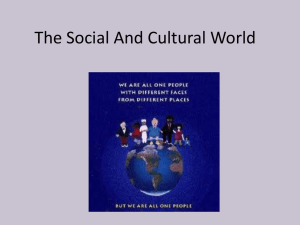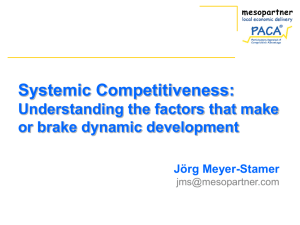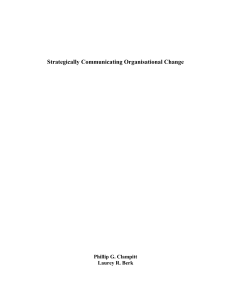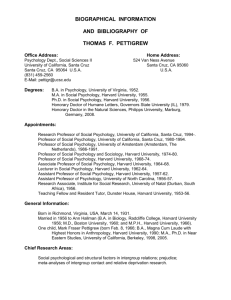`context`?
advertisement
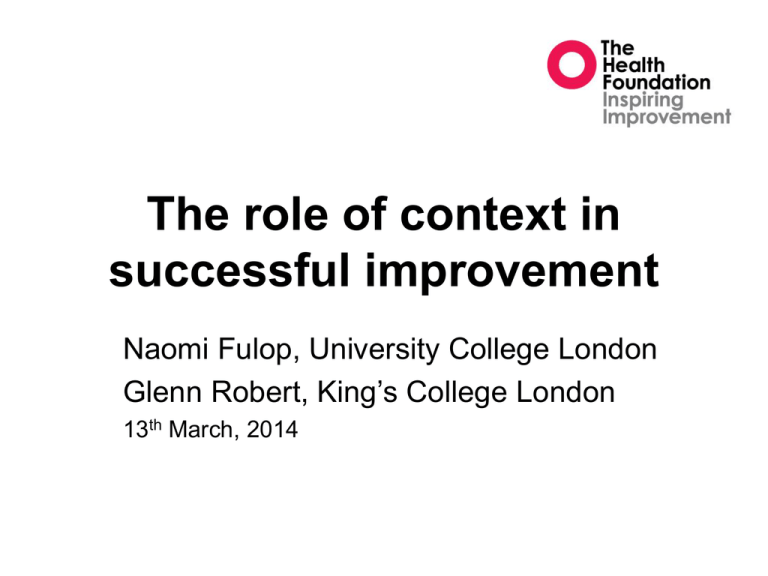
The role of context in successful improvement Naomi Fulop, University College London Glenn Robert, King’s College London 13th March, 2014 Perspectives on context A selection of essays considering the role of context in successful quality improvement Original research March 2014 Why this matters? • Results of QI interventions across health care systems or within organizations mixed, often disappointing • Promising interventions implemented in one setting do not transfer to others, or not sustained • With the benefit of hindsight, the usual explanation offered is ‘context’ What is ‘context’? • ‘Context is everything’ (Gouldner, 1955) • The gardening metaphor….. • “Context refers to the ‘why’ and ‘when’ of change and concerns itself both with influence from the outer context (such as the prevailing economic, social, political environment) and influences internal to the focal organisation under study (for example, its resources, capabilities, structure, culture and politics).” (Pettigrew et al, 1992) • Blurred boundaries between ‘context’ and the ‘intervention’? Which contextual factors are associated with successful implementation of QI interventions in health care organisations: A systematic review • which aspects of context have been found to be important in the implementation of quality improvement interventions? • which aspects are modifiable? • what evidence is there that these aspects have successfully been modified, and resulted in improvement to quality? Receptive contexts for change (Pettigrew et al, 1992) How emotional dynamics influence change dynamics (Huy, 1999) Receptive context for change Quality & coherence of policy Key people leading change System level Environmental pressure Supportive culture Effective managerial/clinical relations Co-operative interorganisational networks Macro: national/regional healthcare system Meso: healthcare organization Simplicity & clarity of goals & priorities Fit between change agenda and locale Micro: front-lineline service/department Domains Structural Psychological (relating to the organization of a system) (relating to mental phenomena) Additional factors Dimensions of literature synthesis (Robert and Fulop, in press) What we found • Majority of studies large-scale, crosssectional surveys • Mostly U.S. • Most common Pettigrew et al features – Organisational culture – Quality and coherence of policy – Environmental pressures • Most studies at meso (organisational) level • Majority studies ‘structural’ cf ‘psychological’ factors – esp at micro level • Very few studies looking at more than one level of the system Some examples of ‘modifiable’ factors • Most studies not of ‘modifiable’ factors • Macro e.g. publication of surgeon’s and hospital’s performance • Meso e.g. introduction of electronic patient record • Micro e.g multi-faceted QI intervention incl financial incentives improved adherence to guidelines The way forward? • Some recent developments in the field e.g. MUSIQ • But attention now needed on psychological/emotional context that facilitates QI • Piloting the acceptability, feasibility and value of reflective tools that enable practitioners to take contextual factors into account before beginning - and during - future QI interventions • Designers of future QI interventions need to consider all three levels of the healthcare system (macro, meso, micro) • Framework for future research: longitudinal, process-based, organizational case studies • QUASER 8 challenges of quality improvement https://www.ucl.ac.uk/dahr/quaser/QUASER-GuideForHospitals Source: Kaplan et al, 2012 Structural: structuring, planning and coordinating quality efforts Political: addressing the politics and negotiating the buy-in, conflict and relationships of change designing physical infrastructure and technological systems supportive of quality efforts Cultural: giving ‘quality’ a shared, collective meaning, value and significance Emotional: Educational: inspiring, energising and mobilising people for quality improvement work creating and nurturing a learning process that supports continuous improvement Physical & technological: Leadership: providing clear, strategic direction QUASER: 8 challenges for QI Managing the external environment: responding to broader social, political & contextual factors Structural: structuring, planning and coordinating quality efforts Political: addressing the politics and negotiating the buy-in, conflict and relationships of change designing physical infrastructure and technological systems supportive of quality efforts Cultural: giving ‘quality’ a shared, collective meaning, value and significance Emotional: Educational: inspiring, energising and mobilising people for quality improvement work creating and nurturing a learning process that supports continuous improvement Physical & technological: Leadership: providing clear, strategic direction QUASER: 8 challenges for QI Managing the external environment: responding to broader social, political & contextual factors Lessons from the Health Foundation Learning Communities Improvement Project: context and skills John Gabbay & Andrée le May (and Jonathan H Klein & Con Connell) Background – The Health Foundation – Quality improvement • “Improvement science” – Organisational learning • Learning communities/ communities of practice 17 Improvement Science? = “proven” improvement methods (e.g:) 18 Underpinned by: • Working with the willing/early adopters • Using clinicians’ own data • Mutual problem-solving “improvement conversation” • Focussing on one or two key agreed problems • Doing small tests of change and adjust as you go • Showing just enough evidence to make the point • Developing ideas of improvement with the clinicians • Getting buy-in through early wins and natural spread 19 Methods – Orientation visit (+topic selection) – Snowball samples (n=9-13 per “improvement group”) – SPIBACC (Systematic Prior Interview-Based Analysis of “Claims & Concerns”) – Prioritisation of improvement tasks – “Learning Events” (to introduce “IS” techniques) – Further interviews (~ 35) + SPIBACC before Learning Events – (9 Learning Events in total) – Participant Observation – Follow up interviews (n=33) 20 Sites • Exemplary QI (?) • 2011-12 • 2 x 2 “Improvement groups” • Furnhills – COPD – Dementia (memory clinic) • Dansworth – Elderly care – Dementia (hospital environment) 21 Furnhills • COPD • Dementia (memory clinic) Dansworth • Elderly care • Dementia (hospital environment) 22 Context • External environment – Continuity – Targets • Internal organisational culture of improvement • Resources, structures and processes • Leadership • Local politics • Relationships: trust and communication 23 Successful Improvement ? The Improvement Pyramid Wasted Skills fall resource! short The Improvement Pyramid Skills Fall fall short Skills Short Implications • Organisational & personal skills are essential for handling context • They are an essential precursor to the application of “hard” IS skills and must be well developed if the latter are to succeed • Learning communities are an effective way to help meld those sets of skills • Learning communities function more effectively when facilitated especially when community learning skills are weak • Achieving sustained improvements with IS may require specific interventions – for learning soft skills – to systematically facilitate the QI process (SPIBACC) so as to get “inside” the contextual concerns and deal with them 27
